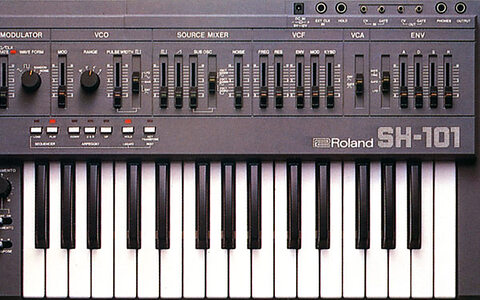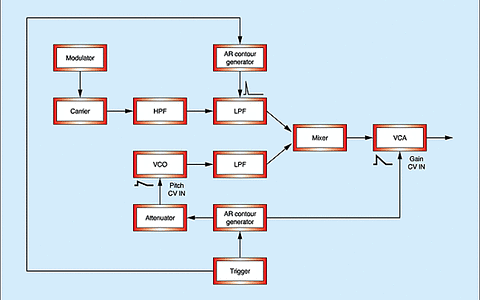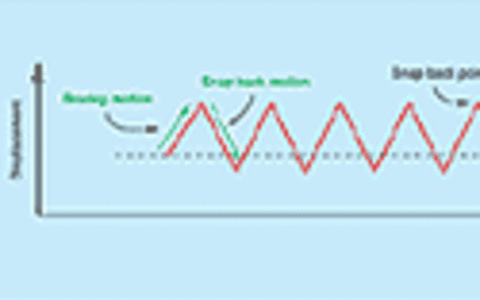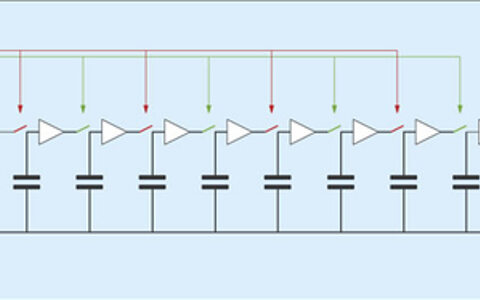Gordon Reid's classic 'synthesis explained' in-depth series ran in Sound On Sound every month, non-stop, over 5 years and is still used by Colleges and University courses as 'essential reading' when teaching the foundations of synthesis and sound design. We've collected all 63 episodes here, for ease and convenience.

What's In A Sound?
In Part 1 of this (63-part) series exploring the world of subtractive synthesis, Gordon Reid goes right back to basics. What are waveforms and harmonics, where do they come from, and how does the theory relate to what we actually hear?

The Physics Of Percussion
In Part 1 we explained how the tones of most real instruments can be reduced to patterns of harmonics, which can be generated using sine, saw, square or pulse waveforms. This month, we consider the sonic raw materials needed to imitate unpitched percussion.

Modifiers & Controllers
We move on from discussing the harmonic components of sound to explaining how they change over time, and some of the tools subtractive synths give you to emulate this process.
![Figure 1 [top] and Figure 2. Figure 1 [top] and Figure 2.](https://dt7v1i9vyp3mf.cloudfront.net/styles/teaser_large/s3/imagelibrary/f/fig1fig2-0899-drTdXKN2Q.4BYJoVKqo_h0J0WDVxuNDX.gif)
Of Filters & Phase Relationships
Having dealt last month with the concepts of envelopes, oscillators and LFOs, Gordon Reid moves on to the subject of filters, and the havoc they wreak on the signals that pass through them.

Further With Filters
Gordon Reid continues his series on the theory of subtractive synthesis by delving deeper into the amazingly complex world of the analogue audio filter.

Of Responses & Resonance
As Parts 4 & 5 of Gordon Reid's series showed, even the simplest analogue filters mess with your sound in complicated ways. In this Part, he considers what happens when you make the design more sophisticated...
![Figure 1: [left] An irregular, non-repeating waveform.](https://dt7v1i9vyp3mf.cloudfront.net/styles/teaser_large/s3/imagelibrary/f/fig1_2-1199-qn1kg0IBD6sDFqsMt7NCi22Lc1obEtlu.gif)
Envelopes, Gates & Triggers
You press a key on your synth. It plays a note. That's it, right? Wrong. We explain the role of envelopes, gates, and triggers in this deceptively simple process.

More About Envelopes
Gordon Reid reveals some of the limitations of the 'classic' ADSR envelope with reference to a practical synthesis example, and explains some of the different types of envelopes found on 'classic' analogue synths, from AR envelopes right up to highly flexible digitally controlled EGs.

An Introduction To VCAs
Having laid bare the inner workings of oscillators, contour generators and filters, Gordon Reid turns his attention to something which at first sight seems entirely self-evident. Can the humble voltage-controlled amplifier really hold any Synth Secrets?
![Figure 1: [top] A simple synthesizer. Figure 2: [bottom] Applying this control voltage to the oscillator frequency would result in a short burst of vibrato. Figure 1: [top] A simple synthesizer. Figure 2: [bottom] Applying this control voltage to the oscillator frequency would result in a short burst of vibrato.](https://dt7v1i9vyp3mf.cloudfront.net/styles/teaser_large/s3/imagelibrary/s/synthsec1_2-0200-qAtfRQgceyPk0EN0dHZIftHUGToqoWju.gif)
Modulation
In this month's instalment of his series on the basics of subtractive synthesis, Gordon Reid considers the magic ingredient that makes all the other elements sound interesting...
![Figure 9: [top] Amplitude Modulation of Signal 1 by Signal 2. Figure 10: [bottom] The harmonic spectrum of the waveform in Figure 9. Figure 9: [top] Amplitude Modulation of Signal 1 by Signal 2. Figure 10: [bottom] The harmonic spectrum of the waveform in Figure 9.](https://dt7v1i9vyp3mf.cloudfront.net/styles/teaser_large/s3/imagelibrary/s/synth9_10-bXq4UpZUMH9toL2LbnyGFvUzcrYZRCTp.gif)
Amplitude Modulation
Last time, we examined the concept of modulation at low frequencies. This month, we speed things up a bit. The result is not just faster versions of the same modulation effects, but a new type of synthesis...

An Introduction To Frequency Modulation
As explained last month, audio-frequency modulation of the amplitude of a signal can be a powerful synthesis tool. The possibilities expand still further when we consider what happens when you use one audio-frequency signal to modulate the frequency of another...

More On Frequency Modulation
Last month, we examined the frankly scary maths allowing you to predict the audible effects of Frequency Modulation. This time, although the maths gets even tougher, Gordon Reid relates the theory to the practical implementation of FM synthesis on Yamaha's digital synths, as well as modular and non-modular analogues.
![Figure 10: [top]. Figure 11: [bottom].](https://dt7v1i9vyp3mf.cloudfront.net/styles/teaser_large/s3/imagelibrary/s/synth10_11-0600-68NYYqRsRshDbS2Ny2P.CiH7TfLazGtW.gif)
An Introduction To Additive Synthesis
Every pitched sound can be thought of as a collection of individual sine waves at frequencies related to the fundamental. Gordon Reid introduces a powerful method of synthesis that works by manipulating these individual harmonics.

An Introduction To ESPs & Vocoders
We turn our attention to the effects that can be achieved when subtractive synthesis components are applied not to the output from oscillators, but to real-world sounds — such as human speech.
![Figure 1: [top] The output from an envelope follower. Figure 2: [bottom] A more sophisticated envelope follower.](https://dt7v1i9vyp3mf.cloudfront.net/styles/teaser_large/s3/imagelibrary/s/synth1_2-0800-0C0zNIUAttbB6Ff8M6IKO1uI8Z34UeVi.gif)
From Sample & Hold To Sample-rate Converters (1)
Gordon Reid introduces the synthesis modules that allow you to create a number of commonly used 'random' effects, and their close relatives — analogue sequencers.

From Sample & Hold To Sample-rate Converters (2)
Sample & Hold modules, as explained last month, convert a continuously varying signal into a stepped series of fixed pitches. And this, as we shall see, is the basis of what we know as 'digital audio'...
![Figure 3: [top] Creating a. Figure 4: [bottom] The chromatic scale generated by the configuration in.](https://dt7v1i9vyp3mf.cloudfront.net/styles/teaser_large/s3/imagelibrary/s/synth6_7-1000-vKJbimsIirZB2IjPodseBZkNla8G0DVZ.gif)
Priorities & Triggers
In these days of 64-note polyphony and 32-part multitimbrality, it's easy to forget the importance of note-priority systems in analogue monosynths — yet they can have a drastic effect on what you hear when you play or trigger an old synth. Gordon Reid provides a refresher course.
![Figure 3: [top] Creating a. Figure 4: [bottom] The chromatic scale generated by the configuration in.](https://dt7v1i9vyp3mf.cloudfront.net/styles/teaser_large/s3/imagelibrary/s/synth7_8-9-1100-.g2YuyNMEcoE4NEQGZlUQfrubZowD_Co.gif)
![Figure 1: [top-left] A simple monosynth. Figure 2: [bottom-left] A four-note broken chord played on a low-note-priority monosynth. Figure 3: [top-right] A four-](https://dt7v1i9vyp3mf.cloudfront.net/styles/teaser_large/s3/imagelibrary/s/synth1_2_3_4-1200-LnVd8udvvUlbYzHRUn7emBwcts7cRLAI.gif)
Introducing Polyphony
Having explored the way monophonic and duophonic analogue keyboards work, Gordon Reid puts away his Minimoog and Odyssey and descends into the complex world of polyphonic synths to a flourish of complex jazz chords.
![Figure 1: [top-left] A paraphonic synthesizer. Figure 2: [bottom-left] A fully polyphonic analogue synthesizer. Figure 3: [right] Octave divider boards. Figure 1: [top-left] A paraphonic synthesizer. Figure 2: [bottom-left] A fully polyphonic analogue synthesizer. Figure 3: [right] Octave divider boards.](https://dt7v1i9vyp3mf.cloudfront.net/styles/teaser_large/s3/imagelibrary/s/synth1_2_3-0101-muEtxP7wD74DHo.jL_rSEge628JVxWw1.gif)
From Polyphony To Digital Synths
This time, Gordon Reid explains how various analogue synth manufacturers attempted to create workable polyphonic synths by employing digital technology.

From Springs, Plates & Buckets To Physical Modelling
Onboard effects may seem like a relatively recent synth innovation, but even old modular synths offered analogue effects. Although they were basic, the freely patchable nature of modular synths allowed them to be used to create convincing acoustic instrument sounds — thus effectively physical modelling. Gordon Reid explains how.

Formant Synthesis
Ever heard a synth talk? If you have, it's due to formant synthesis. Gordon Reid explores the theory of analogue formant synthesis, how it relates to the human voice and modern digital synths like Yamaha's FS1R.

Synthesizing Wind Instruments
Gordon Reid embarks on a journey to synthesize convincing woodwind and brass. This month, he considers how these instruments make their sounds in real life.

Synthesizing Brass Instruments
Gordon Reid builds on the acoustic theory of wind and brass instruments he introduced last month, and explains how to produce a convincing analogue trumpet sound.

Brass Synthesis On A Minimoog
Last month we looked at how analogue modules can reproduce the sound of a real trumpet. All very well if you own a wall-sized modular system — but what if your means are more limited? Gordon Reid adapts theory to practice with a Minimoog.

Roland SH101 & ARP Axxe Brass Synthesis
Gordon Reid concludes his attempts to adapt an idealised analogue brass patch so that it can be programmed on real synths. This month, he looks at the Roland SH101 and ARP Axxe.

Synthesizing Plucked Strings
Having dealt exhaustively with the mechanics of brass instruments and how to go about synthesizing them, we turn to instruments that use plucked strings to generate their sound, taking the complexities of the acoustic guitar as an example.

The Theoretical Acoustic Guitar Patch
Having explained last month the reasons why analogue synthesis of guitar sounds should be well-nigh impossible, Gordon Reid puts the theory to the test...

A Final Attempt To Synthesize Guitars
Having proved that subtractive synthesis of an acoustic guitar is completely impractical, Gordon Reid tries his hand at the electric variety, and deconstructs some past attempts to emulate the sound via analogue means.

Synthesizing Percussion
Synth Secrets turns its attention to the synthesis of percussion instruments, beginning with pitched drums.

Practical Percussion Synthesis: Timpani
Building on the theory of what makes up the sound of timpani, this month's Synth Secrets reveals how to synthesize realistic kettle drums using a Korg MS20 and a Yamaha DX7.

Synthesizing Drums: The Bass Drum
Ever wanted to synthesize unpitched membranophones? No? Well, you might if you knew that bass and snare drums are of this percussion type. We show you how...

Practical Bass Drum Synthesis
Moving from last month's theoretical bass drum synth patch to its practical application on affordable analogue synths, we also take a look at how the world's most famous drum machines produce this fundamental rhythm sound.

Synthesizing Drums: The Snare Drum
If you thought synthesizing realistic bass drums was complex, that's nothing compared to snares. So how is it that the analogue snare sound is so well known? And how do you go about creating it? We find out...

Practical Snare Drum Synthesis
Last month, we revealed just how hideously complex the sound-producing mechanism of the snare drum can be. Nevertheless, synthesizing the sound is not as hard as it seems, as we find out with the aid of a Roland SH101...

Analysing Metallic Percussion
The task of synthesizing convincing metallic percussion defeated many synth giants — you only need to listen to Kraftwerk's weedy cymbals on 'The Model' to be persuaded of that. So why is it so difficult? We find out...

Synthesizing Realistic Cymbals
Having analysed the complex process by which a cymbal makes its sound, it's time to synthesize our own...

Practical Cymbal Synthesis
Synthesizing realistic cymbals is complex, but not impossible — after all, over 20 years ago, Roland's TR808 drum machine featured synthesized cymbals. We look at how they managed it, and attempt to create cymbals on another affordable analogue synth.

Synthesizing Bells
Having come up last month with a reasonably realistic cymbal patch, it's time to take the principles of synthesizing metallic percussion one stage further, and produce bell sounds. But there's more to this than you might think...

Synthesizing Cowbells & Claves
Having learned last month how to synthesize tuned bells, we turn this time, in the last of this series on the subject of percussion, to untuned bells — in the form of the humble cowbell — and claves.

Synthesizing Pianos
Surely the only convincing synth pianos are sample-based ones? A sound as rich and expressive as that of an acoustic piano is far too complex to be rendered by subtractive synthesis... isn't it? Let's find out...

Synthesizing Acoustic Pianos On The Roland JX10 [Part 1]
As explained last month, synthesizing the sound of an acoustic piano is difficult, but it can be done reasonably realistically, as the 1986-vintage Roland JX10 shows. We find out how Roland managed it...

Synthesizing Acoustic Pianos On The Roland JX10 [Part 2]
How did they make that sound on a subtractive synth? We continue to dissect the analogue 'Acoustic Piano' Performance from Roland's 1986-vintage JX10.

Synthesizing Acoustic Pianos On The Roland JX10 [Part 3]
When trying to copy a real piano with an analogue synth, if one patch doesn't quite do it, two just might...

Synthesizing Strings: String Machines
Analogue synths can't synthesize every sound, but the attempts made to replicate the sound of orchestral strings were so successful that so-called string machines became much-loved instruments in their own right. We begin a voyage into the world of synthesized strings...

Synthesizing Strings: PWM & String Sounds
Pulse-width modulation is a vital tool in achieving lush-sounding synthesized string pads — so what if your synth doesn't have it? Fear not, for PWM can itself be synthesized. Here's how...

Synthesizing Bowed Strings: The Violin Family
Following our success at synthesizing the sound of analogue string machines, we hone our techniques with a view to recreating the sound of the real thing...

Practical Bowed-string Synthesis
Having looked at the mechanics of how a bowed string instrument generates its sound last month, it's time to put these principles into practice, using nothing more complex than a miniKorg 700 monophonic synth...

Practical Bowed-string Synthesis (continued)
After putting all our bowed-string synthesis theory into practice on a Korg 700 last month, we found that the result was only acceptable as a string sound with a lot of wishful thinking. Can we improve on it?

Articulation & Bowed-string Synthesis
The skilful articulation of a synthesized string patch can improve it no end, even one created using very basic building blocks, as we saw at the end of last month. But we can take this approach much further...

Synthesizing Pan Pipes
The characteristic sound of flute-like instruments is complex — but fortunately not so complex that it can't be emulated fairly successfully with a synthesizer...

Synthesizing Simple Flutes
The Monty Python team once famously claimed that being able to play the flute was a simple matter of 'blowing here, and moving your hands up and down here'. But there's a lot more to it than that...

Practical Flute Synthesis
As we saw last month, there's much to synthesizing a convincing flute sound — and yet basic analogue monosynths have offered reasonable flute patches for 30 years. Surely the process can be simplified?

Synthesizing Tonewheel Organs: Part 1
Long before Bob Moog built his first synth, there was the Hammond tonewheel organ; effectively an additive synthesizer, albeit electro-mechanical rather than electronic. So emulating a Hammond with an analogue synth shouldn't be too hard, right? Well...

Synthesizing Tonewheel Organs: Part 2
If you followed last month's advice, you'll know how to synthesize a basic Hammond tone on a Roland Juno 6. But can the same technique be applied to any other synth?

Synthesizing Hammond Organ Effects
So, you can synthesize a Hammond's tonewheel generator -- but what about its all-important effects? This month, we look at recreating the Hammond's percussion, vibrato, overdrive, and reverb -- and find that it's harder than you might think...

Synthesizing The Rest Of The Hammond Organ: Part 1
As with so much surrounding the Hammond organ, there's much more to the Leslie rotary speaker than meets the eye, and synthesizing its effects involves considerably more than just adding vibrato, as we find out in this installment.

Synthesizing The Rest Of The Hammond Organ: Part 2
We conclude our analysis of the fabulously complex beast that is the Leslie rotary speaker.

From Analogue To Digital Effects
When synthesizing sounds, the effects you place after your synth's output are often as important as the synth itself (just think of last month's Leslie). As we near the end of Synth Secrets, we consider how a digital effects processor works.

Creative Synthesis With Delays
Effects can play just as important a role in sound creation as the elements in a synth's signal path — provided you have access to their constituent parts. We take a closer look at effects synthesis using simple delays.

More Creative Synthesis With Delays
In the penultimate instalment of this long-running series, we delve deeper into what can be achieved with just a few delays and some creative routing...

The Secret Of The Big Red Button
After more than five years, Synth Secrets reaches its conclusion (and conclusions!). Will we ever look at synthesis in quite the same way again?
